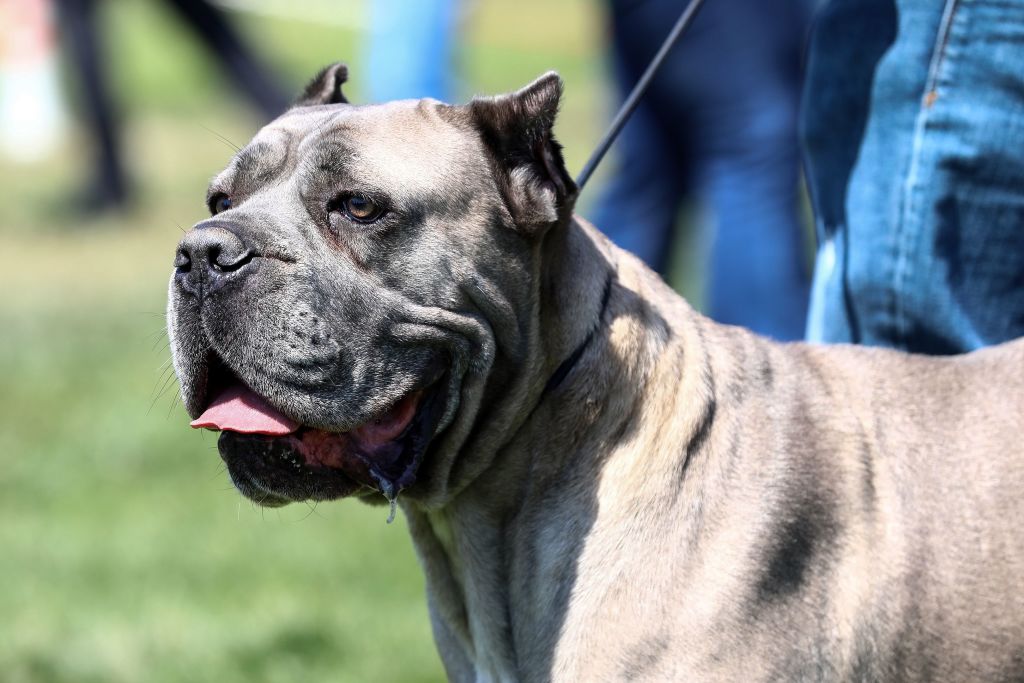My dog is great with children, I will give her that. The family pet and I don’t really get on, and since I last wrote on the subject of ‘Twiggy’ I’m afraid there has been no great budding human–canine love story; I won’t be played by Owen Wilson in the biopic of her life any time soon. She is warm and affectionate around people but has a relentless desire to hunt – rats, pigeons, squirrels and mice have all on occasion fallen prey, much to the distress of some members of the public.
This ends up causing great inconvenience because Twiggy regularly gets trapped or lost while out hunting, and we have to waste hours looking for her. On one occasion in Epping Forest we spent ages digging her out of a massive hole she’d got herself stuck in, nobly assisted by a passing Weimaraner which had instinctively come to help a fellow dog in distress. After some struggle we finally lifted Twiggy out, and the Weimaraner immediately started trying to hump her.
Twiggy regularly wakes us up with her incessant barking because there are foxes in the alleyway behind us; but when, last November, a burglar broke into our back garden to steal two bikes, she gently slept through the night without a care in the world. She just has no interest in human threats and clearly doesn’t feel that it’s her responsibility.
Dog breeds have different natures, yet the leading authorities in the British dog world seem to be in denial about it
It’s not the dog’s fault, of course; it’s just the way she is. My wife has done a very good job of training Twiggy, but she is a Portuguese Podengo – a sighthound noted for its ‘less domesticated’ behaviour and its desire to hunt. It is, however, a loving family pet if you don’t mind the occasional afternoon spent wandering around the woods calling her name.
Rather than objecting to a dog out of principle, I probably should have done more to choose a breed that suited my temperament. We once had a Labrador staying with us, a dog with no interest in attacking any animal and who just wanted to lie on the sofa eating carbohydrates, very much more my spirit animal; in fact it had such a compulsive eating problem that I was forced to retreat to the shed to have my meals away from him.
Dog breeds have different natures, something that would seem self-obviously true and yet which today the leading authorities in the British dog world seem to be in denial about, in particular when it comes to one of the unspoken trends of recent years – the huge increase in dog attacks.
This spike in dog-bites-man violence has led to a 50 per cent increase in hospital admissions for dog bites over ten years, the biggest rise being among children under the age of four. Overall the number of fatalities has gone from an average of 3.3 in the 2000s to 10 last year, while dog attacks have risen recently from 16,000 in 2018 to 22,000 in 2022, and hospitalisations have almost doubled from 4,699 in 2007 to 8,819 in 2021/22.
The underlying story behind this escalation of violence is that much of it is the work of just one breed: the American Bully. And as we enter the summer holidays, the peak period for dog attacks, it’s worth pondering why the experts in the dog world are in such denial about the issue.
Public awareness of the American Bully problem has grown in recent months, spurred by some especially horrific attacks, as well as a widely-read article by legal academic and YouTuber Lawrence Newport. Lawrence looked at the data on dog attacks and observed that ‘a notable pattern emerges. In 2021, two of the four UK fatalities were from a breed known as the American Bully XL. In 2022, six out of ten were American Bullies. In 2023, so far all fatalities appear to have been American Bullies.’
There are dogs I would never allow my children to go near under any circumstances – namely the American Bully XL
American Bullies, Newport explains, ‘are a breed resulting from modern mixes of the American Pitbull Terrier. They are known for very high muscle mass, biting power, and impressive strength, and come in several variations. Those that are bred for the greatest strength, weight and size are known as a part of the American Bully XL variety.’
Pitbulls are banned in Britain for a good reason, and in the US are responsible for ‘60–70 per cent of dog fatalities’; yet under the Dangerous Dogs Act 1991 ‘the American Bully XL is currently permitted.’
What is surprising, Newport writes, is that ‘if you argue these dogs are dangerous, you will get a flood of comments from people…saying it’s the owner’s fault, not the dog’s. You might even be thinking this yourself, right now. But this is wrong. While many Brits would contend that ‘Guns American Bully XL’s don’t kill people, people do’, the reality is different.
‘Labradors retrieve. Pointers point. Cocker Spaniels will run through bushes, nose to the ground, looking as if they are tracking or hunting even when just playing – even when they have never been on a hunt of any kind. This is not controversial. Breeds have traits. We’ve bred them to have them.’
Pitbulls were created for bull-baiting, and when that was banned, they came to be bred to hunt down rats in a locked pen. ‘This required more speed, so they were interbred with terriers to make Pitbull Terriers. In addition to this, they began to be used for dog fighting: bred specifically to have aggression towards other dogs, and to be locked in a pit to fight (some are still used for this today). These were dogs likely kept in cages, away from humans, and bred for their capacity to earn money for their owners by winning fights. These were not dogs bred for loyalty to humans, these were dogs bred for indiscriminate, sustained and brutal violence contained within a pit.’
One reason for the widespread denial about breed violence might be simple animal sentimentality, a particular trait of the British. Newport cites the case of two American Bully types recently shot by police, an incident which led to a million signatures on a petition calling for the officers to be prosecuted, even though the dogs had attacked other dogs and had previously attacked at least one person: ‘Not only this but the woman who had her dogs attacked by the pair said she was “mortified” that they had been shot and had been “crying ever since”. There are plans for a nation-wide vigil for the dogs.’
As Newport points out, it is not a dog’s fault that it’s been bred for certain traits, but it also doesn’t help those buying puppies to pretend that they are dealing with a blank state, for ‘potentially good owners are left at a severe disadvantage by the statements of advocates for Pitbulls and American Bullies’.
 An American Pit Bull (Credit: Getty Images)
An American Pit Bull (Credit: Getty Images)
They are told ‘that American Bullies are naturally good with kids and family, that they are naturally non-violent, and that this isn’t a risk. Positive descriptions of American Bullies (and their XL variety), de-emphasising their violent tendencies, run the very real risk of obfuscating future owners of the traits in the breed and thereby stopping those owners from correctly understanding and controlling their dog.’
There have been plenty of diligent dog owners who nevertheless found themselves in danger. ‘Whether it’s an experienced dog walker that warned others to stay away to save themselves whilst she was mauled to death, or the killing of an experienced dog and cat kennel owner described as “the most caring man”, or a mother that had the American Bully for a week before it killed her baby by taking it directly from her arms. It is not the owners. It is the breed.’
Newport suggests that the American Bully XL be added to the Dangerous Dogs Act, something within the Government’s remit, and he may succeed; the policing minister has recently said that banning the Bully is an option. This would almost certainly save lives, and there is evidence that anti-Pitbull laws actually work. On the other hand, he’s up against the most powerful force in British society – animal lovers – added to which there is widespread denial about breed differences, even among experts.
Pitbulls are banned in Britain for a good reason
Newport writes that ‘the UK Kennel Club considers the Dangerous Dogs Act to be unacceptable insofar as it bans any breeds, arguing instead that “no breed of dog is inherently dangerous” and, instead…“any dog in the wrong hands has the potential to be dangerous”’.
The RSPCA, arguably the most well-known and powerful charity in Britain, recently stated that ‘focussing on the type of dog, rather than their individual actions, is a flawed and failing approach. Dog aggression is highly complex, and taking a breed-focused approach is fundamentally flawed.’
The charity also campaigns against breed-specific legislation because it is both an injustice for the animals and because dog bites have continued to go up since the Dangerous Dogs Act, one of many examples where the British dog lobby uses similar logic to the American gun lobby.
Contrary to what these groups believe, scientist Stuart Ritchie wrote in the i last week that there is considerable evidence of behavioural differences by breed, including one study of 46,000 dogs which showed ‘what you’d expect just from cultural stereotypes: terriers are more aggressive and prone to chase little animals; scent-hounds are extremely trainable, and so on’.
Ritchie wrote that: ‘The claims made by members of the Dog Control Coalition and others shift between breed not being a “reliable” predictor of risk, and it not being a predictor of risk at all. Everyone would agree that breed isn’t a perfect predictor of behaviour – far from it. And everyone would agree that within a breed there can be huge variations in personality. But I don’t know how you can look at the research – flawed as it is – and claim that it has nothing at all to do with how a dog will act, on average.’
Ritchie also found studies suggesting that Pitbulls don’t just bite more children, but also that their bites are far more violent (more often targeted at the face rather than the hands). This is called a ‘myth’ by campaigners, but it could be that their myth-busting is an example of anti-intuition, of experts denying obvious common sense. Where expert pronouncements clearly defy logic, people are often much better off trusting their instincts.
When the horrible death of dog walker Natasha Johnston was first reported there were all sorts of theories about how she was killed by the entire pack, including dachshunds, and that this was explained by some complex canine psychology. This seemed obviously implausible, and indeed the tragic story turned out to be far more predictable – she was most likely killed by her own dog, an American Bully XL.
One theory for why the blank slate rose in popularity is that large numbers of people now grow up in small families and away from nature, and so are blind to the obvious genetic influences on personality. All personality traits are in some way under genetic control, so the effects of breeding the most violent members of a population over successive generations would be huge and self-explanatory. But even in urban environments it’s obvious that some types of dogs are just extremely dangerous by nature.
In a recent report on dog violence, the Daily Mail stated that ‘84 per cent of parents leave their kids unsupervised around their pets’, but this is rather unsurprising; we leave our children unsupervised around Twiggy because, annoying as she is, a Podengo would almost never attack a child. But there are breeds I would feel uncomfortable leaving my kids around if I didn’t know the owners or dogs – Staffies, German Shepherds or Rottweilers, all of which possess great strength and higher levels of aggression. And then there are dogs I would never allow my children to go near under any circumstances – namely the American Bully XL. And for that we shouldn’t automatically blame the people in charge. Sometimes it’s not the owners, it’s the breed.
This article first appeared on Ed West’s substack, the Wrong Side of History
Got something to add? Join the discussion and comment below.
Get 10 issues for just $10
Subscribe to The Spectator Australia today for the next 10 magazine issues, plus full online access, for just $10.




















Comments
Don't miss out
Join the conversation with other Spectator Australia readers. Subscribe to leave a comment.
SUBSCRIBEAlready a subscriber? Log in